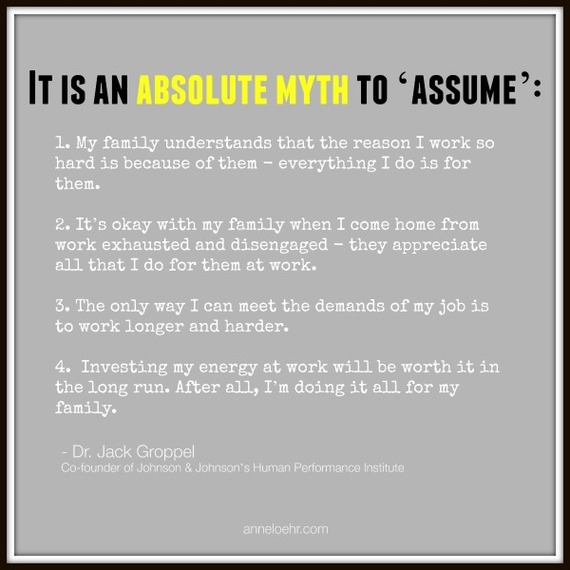You may have read the article I recently published in The Huffington Post with co-authors Dr. Jack Groppel (co-founder of Johnson & Johnson's Human Performance Institute) and Tom Ward (founder of TNL Ltd.). In that article, leveraging Jack's depth of knowledge and expertise in the domains of human performance and energy management, we make the case that being at your best as a leader comes from being fully engaged. To cultivate The Leader's Edge, we argue that learning to manage your most precious of human resource, energy, is the key.
We believe leadership, both personal and professional, is an energy game. So, just like professional athletes, business leaders need to train intentionally, properly and regularly to manage their energy -- physical, emotional, mental and spiritual -- and achieve the results they're after.
In this article, we delve further into what it takes to develop The Leader's Edge. And you might be surprised to learn about the essential role proper recovery plays. Tom is going to share with you the story of one of his clients, and Jack is going to offer Tom some coaching on how he might work with his client to get him back on track.
Tom's Client
In my line of work, I regularly engage with highly motivated, success-driven individuals. To say that they're "high octane" would be an understatement. Recently, I began working with a 42-year-old entrepreneur who is in the midst of getting his VC-funded, software start-up's flagship product into beta. I'll refer to my client as Dave, though that's not his true name.
Some background on Dave*: He, his wife and two children live in Silicon Valley. Though they hope to own a home again one day, they sold their home in Fort Worth, TX two years ago and moved, along with the business, to California where they live in a two bedroom apartment near work and have invested everything they have in the business. Money is tight, but Dave is confident the business will succeed. "It's got to," he says.
Dave works incessantly, sometimes logging as many as 100 hours in a week. When he's not at the office, he's rarely available to his family. His face is constantly buried in his laptop and smartphone, even during family meals. His 4- and 6-year-old boys rarely catch a glimpse of him.
Recently, Dave and his wife have begun to notice frays in the fabric of their marriage. To her, it seems like Dave has no time for the family. "Sometimes I wish we never moved here," she says. "At least we used to see him." Dave hasn't taken a weekend off in months, and the family has not vacationed since they left Fort Worth. For his part, Dave's attitude is "I do it all for them; can't they see how hard I'm working?"
At the office, Dave is constantly on edge. The stress is palpable. Generally thought to be an affable guy, Dave's become short-tempered and curt lately. His co-founder and their 12 employees have begun to worry about him. In addition to flying off the handle at the slightest mention of a deadline possibly slipping, Dave has gained 30 pounds over the past year. Fueled by caffeine and junk food, Dave's constantly tired. His nightly four hours of sleep just doesn't seem to be enough for him lately.
At the behest of his wife, Dave's co-founder has hired me to help Dave find a better way forward. Jack, I could sure use your advice and counsel.
Jack's Advice
Dave is certainly not alone here, as it relates to what work sometimes does to us. In fact, he is living some of the most powerful myths out there. It is an absolute myth to 'assume':
- My family understands that the reason I work so hard is because of them -- everything I do is for them.
- It's okay with my family when I come home from work exhausted and disengaged -- they appreciate all that I do for them at work.
- The only way I can meet the demands of my job is to work longer and harder.
- Investing my energy at work will be worth it in the long run. After all, I'm doing it all for my family.
These four myths live daily in the lives of many business leaders. They have bought into these myths thinking, as our culture would have you believe, that the only path to success is 'nose to the grindstone at all costs.' Almost every one of us has heard an 'older' person say the following: The only way to succeed is to never let up, persevere, nose to the grindstone, and on and on. And, while I will never belittle perseverance as a critical attribute to success, we have to step back, look in the mirror and then understand what life may have been like for this 'older' person. What was life like 15-20 years ago, and before that?
Prior to 1995, if someone needed to speak with a colleague after work hours, it was a difficult thing to do. The seeker had to go out of his/her way to locate that person. Cell phones and PDAs were not nearly as common, so often the seeker had to leave a message on a home answering machine and hope it was received in a timely manner.
Today is NOT like that at all. We are accessible 24/7/365 on our smartphones, and our colleagues KNOW that we are accessible. That is, unless you have clearly set boundaries, are intentional about what matters most to you, and make clear choices when you need to. What might this look like in Dave's case? It actually begins with disengaging, and getting recovery, from work.
One of the most difficult skills to learn is to disengage from a project (or multiple projects) at work. After all, and as just described, it is the antithesis of how we've grown up. But, you must disengage, if you want to be a world-class performer. Now, I'm not talking about slacking off, but I am talking about giving your mind and body the biological recovery it needs. And, as difficult as it might seem and, without knowing it, it's possible that you've done it before.
Many of us have, during our workday, had the opportunity to speak with a young child. Perhaps it was your own child or a niece or nephew? If you have done this, I ask you to revisit that moment. And, if you haven't done so, just image it as I explain the situation.
You're having a really bad day, putting out one fire after another. You literally describe your day as drinking from a fire hose. And, the opportunity arises -- to talk to this child. Picture the child answering the phone and picture your response. Did you say, "Well, I don't know about you, but my day absolutely stinks!"? I don't think so. You probably said something more like this, "Hey sweetheart! How are you? I've missed you so much. And, I cannot wait to see you when I get home! I'm sending hugs, ok?"
So, how did you suddenly change gears to speak so gently to the child? First, you recognized that the child doesn't care, nor understand, that you're having a bad day. And, you also realized that complaining on the phone will go nowhere. You disengaged from your 'bad' day, and engaged in a conversation with the child, and then when the conversation ended, you hung up. And, I'll bet that you felt better after the emotional connection with the child. What happened was that you got recovery from work, which gave you an emotional energy boost. So, how can you bring this into your everyday habit structure?
There are three steps to follow:
- Be sure to get an energy recovery break at least every 90 - 120 minutes.
- When you go into recovery, disengage from what you've been experiencing and engage in recovery. The recovery could be physical, emotional, mental or spiritual.
- Then, when finished recovering, re-engage with work.
The kinds of things that can provide you with recovery include: going for a 5-minute walk; walking up a couple of flights of stairs; sharing a snack with a friend; connecting (truly connecting, not just 'checking in') with a friend or loved one; consciously changing mental tasks; reading the comics or something else that may make you laugh; and reading inspirational or spiritual material.
The goal in the recovery break is to refresh yourself; physically, emotionally, mentally and/or spiritually. Both your mind and body will be biologically prepared to perform better on demand.
------------------
Today's business challenges are tremendous. What's more, they are ever-increasing. Stress and its attendant pressures can wreak havoc on our lives. But, as we've learned from Dr. Jack Groppel, effectively responding to today's leadership challenges demands a strategic approach -- an approach rooted in managing our most precious human resource, energy. By consciously building The Leader's Edge, though, it's possible for business leaders to not only address their challenges but also to thrive. Strategic recovery and renewal are integral to the process.
In a coming post, my co-authors and I will continue our discussion of The Leader's Edge. We'll discuss how by using HPI's energy management system, a proven framework with strategies for expanding one's energy, we can rise to and deal with the most difficult challenges in life -- even those New Year's resolutions we often make only to break! We look forward to continuing the journey with you.
*Please note: Identity and circumstance information have been changed to protect against any privacy concerns


